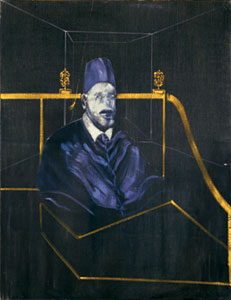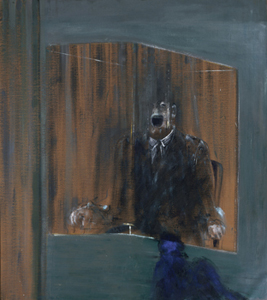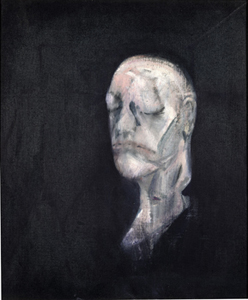



Terror and Beauty at the AGO - Francis Bacon and Henry Moore
Terror and Beauty at the AGO - Francis Bacon and Henry Moore
Image: Francis Bacon's Second Version of Triptych.
“Terror and Beauty” is apparent in every work by Bacon and Moore, as both artists drew inspiration for their work from personal encounters with war and its death and ideals. The works are plentiful and enormous, with a total of 23 works by Bacon, and 81 by Moore, which includes some of his sketches, paintings, and maquettes of sculptures. Among the large-scale pieces by Bacon and Moore are historical photographs of the Blitz by German-born, British photographer Bill Brandt. In addition to the various artworks and photographs, the AGO has provided various quotes from both artists and a detailed timeline that places their work in a historical context.
Meandering my way through the exhibit, trying to keep in mind the many facts that I’d just learned in five minutes worth of reading, I couldn’t help but be moved by the individual works regardless. The size of Moore’s work is astonishing, and the detail of his sculptures is enough to keep one staring, but there is so much to see.

Terrible or beautiful?
Terrible or beautiful?
Image: Moore's Reclining Figure
For this exhibit the AGO has loaned many works by Bacon and many more by Moore from outside collections even though the AGO itself boasts the largest public collection of Moore’s work in the world. At the AGO this collection of over 900 works can be found in The Henry Moore Sculpture Centre, and is well worth seeing. Highlights of Francis Bacon’s work include the painting Second Version of Triptych 1944, 1988, a painting similar to his earlier, famous work Three Studies for Figures at the Base of a Crucifixion, c.1944. Bacon described the figures in the work as the Erinyas (Furies) of Greek mythology, the deities of vengeance. The figures in the work certainly appear that way; they are distorted and disturbing and their soft, round shapes are confined by hard edges resembling odd bits of furniture. What is most striking about this work, besides its large scale, is the velvet-like quality that it and many of Bacon’s other paintings, achieves. The theme of distorted figures in velvet is continued in his series of portraits Study for Portrait (Man in a Blue Box), 1949, Study for Portrait VI, 1953, and Study for Portrait II (after the life mask of William Blake), 1955. Highlights from Henry Moore’s sculptures include Reclining Figure, 1951 and Falling Warrior, 1956-57.
Moore’s sculptures are reminiscent of organic forms like the gangly branches of a tree that could be found in the woods near to where I grew up, more so than the human forms that they strive to imitate. Moore’s work can be seen throughout the city, Large Two Forms is next to the AGO, and Three Way Piece No. 2 (The Archer), (1964–65) sits just outside of Toronto’s City Hall. The curators attempts to link the artworks and themes of these two artists appear trite at times, pitting painting of body with sculpture of body and crucifixion with crucifixion, however, through this, the contrast of their work becomes apparent. However, the supple, colourless forms of Moore’s sculptures contrast the more colourful paintings by Bacon, while at the same time the confinement of Bacon’s figures bring out the confinement of the figure in Moore’s sculptures.

Biomorphism, Bacon and Moore
Biomorphism, Bacon and Moore
Image: Francis Bacon's Un Chien Andalou
Besides the Second World War, Bacon and Moore also drew influence from other sources, notably from the Surrealist movement and artists like Picasso, specifically his biomorphic figures. In the same tone, Bacon’s work brings to mind the infamous scene of a woman’s eye being slit in the famous short silent Surrealist film Un Chien Andalou (The Andalusian Dog), 1929. Dark and distorted is an accurate description of the content and the atmosphere that is created by the artworks of Francis Bacon and Henry Moore.
Picasso's Acrobat
While exploring the exhibit, there were several moments where I felt the need to sit down, to simply contemplate a work and to massage my neck from reading the numerous quotes and historical anecdotes placed around the gallery. However, the few seats available were scattered where they didn’t really count. Despite this, the experience of Francis Bacon and Henry Moore: Terror and Beauty at the AGO was enjoyable, albeit a little dark and brooding, and I would suggest a trip to this exhibit. Bacon and Moore’s artwork is not only about war, but also about the body and its limitations, though it is apparent that neither artist was confined by the limits of their medium.
Francis Bacon and Henry Moore: Terror and Beauty runs until July 20th. Check the Art Gallery of Ontario website for location, hours, and admission costs.








![[Exhibition Review] Doors Without Keys by Abbas Kiarostami at Toronto's Aga Khan Museum @AgaKhanMuseum](https://images.squarespace-cdn.com/content/v1/519a797fe4b07a77f10dc2ff/1448164535006-CUEBM0O1QG1NTW4XQXHO/image-asset.jpeg)